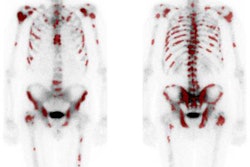
Using ultrasound to guide focused ultrasound treatment for bone metastases pain is feasible and effective, according to a study published online March 4 in Ultrasound Medicine & Biology.
The study findings offer patients and clinicians an alternative to MRI, which has been the modality most often used to perform the procedure but which has its limitations, wrote a team led by Leah Drost of the University of Toronto in Ontario.
"Previous generations of focused ultrasound devices have featured MR image guidance," the group wrote. "These devices have been found ... to be tolerable, effective, and noninvasive in the palliation of metastatic bone pain. ... However, potential drawbacks of such devices include the cost attached to MR equipment, the immobility of the unit, the complex positioning required of the patient, and the long treatment duration."
Drost and colleagues sought to evaluate whether a standalone, portable focused ultrasound device could be guided by diagnostic ultrasound rather than MRI for this application. The study included nine patients treated with focused ultrasound guided by ultrasound. The team assessed the procedure's safety and efficacy 10 days after it was performed.
The researchers found the following:
- The procedure was safe and tolerable. Four patients reported minor skin irritations.
- Average pain score decreased from 6.9 at baseline to 3.2 at day 10. P atients' use of analgesics also decreased from baseline to day 10.
- Six patients reported "durable" pain relief over the assessment period.
"Our study provides evidence that ultrasound-guided focused ultrasound is a safe, tolerable and versatile procedure," the researchers concluded. "It appears to be effective in achieving durable pain response in patients with painful bone metastases. Further research is required to refine the technology and optimize its efficacy."



















